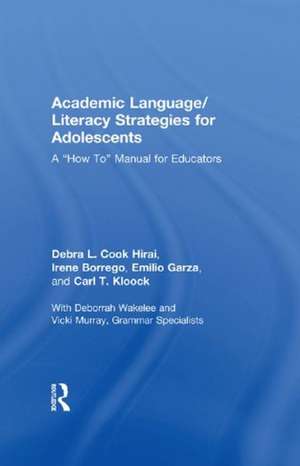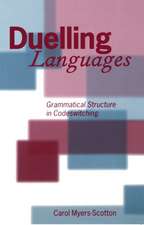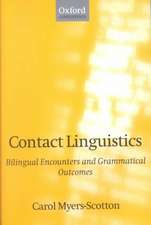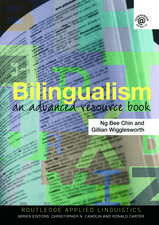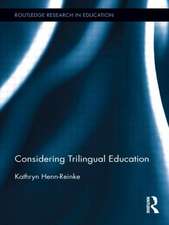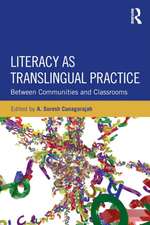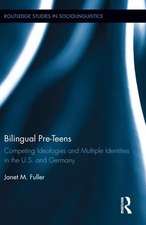Academic Language/Literacy Strategies for Adolescents: A "How-To" Manual for Educators
Autor Debra L. Cook Hirai, Irene Borrego, Emilio Garza, Carl Kloocken Limba Engleză Hardback – 28 oct 2009
Based on a strong professional development model the authors have been instrumental in designing, Academic Language/Literacy Strategies for Adolescents addresses:
- motivation
- attributes of academic language
- vocabulary: theory and practice
- reading skills development
- grammar and writing.
In this era of increased accountability, coupled with rapid demographic change and challenges to traditional curricula and pedagogical methods, educators will find this book to be a great resource.
Preț: 935.99 lei
Preț vechi: 1256.34 lei
-25% Nou
Puncte Express: 1404
Preț estimativ în valută:
179.11€ • 191.52$ • 149.33£
179.11€ • 191.52$ • 149.33£
Carte tipărită la comandă
Livrare economică 18 aprilie-02 mai
Preluare comenzi: 021 569.72.76
Specificații
ISBN-13: 9780415999656
ISBN-10: 0415999650
Pagini: 304
Ilustrații: 50 tables and Medium
Dimensiuni: 152 x 229 x 20 mm
Greutate: 0.72 kg
Ediția:1
Editura: Taylor & Francis
Colecția Routledge
Locul publicării:Oxford, United Kingdom
ISBN-10: 0415999650
Pagini: 304
Ilustrații: 50 tables and Medium
Dimensiuni: 152 x 229 x 20 mm
Greutate: 0.72 kg
Ediția:1
Editura: Taylor & Francis
Colecția Routledge
Locul publicării:Oxford, United Kingdom
Cuprins
FOREWORD
PREFACE
ACKNOWLEDGEMENTS
CHAPTER 1 BACKGROUND
A short history of the term "Academic Language"
Instruction from an Academic Language perspective
Why should we teach Academic Language?
How this book can help
CHAPTER 2 MOTIVATION
The importance of motivation
Research on student motivation
Setting a purpose for learning: The anticipatory set
Active learning and hands-on activities
Modeling and guided practice
CHAPTER 3 ATTRIBUTES OF ACADEMIC LANGUAGE
Receptive and expressive language
Application of receptive and expressive strategies
Professional input and feedback for Academic Language literacy Instruction
CHAPTER 4 VOCABULARY: THEORY AND PRACTICE
Developing vocabulary
Learning and acquisition: The importance of multiple exposures
Cognates, root words, and affixes
Contextualizing vocabulary
Personalizing and operationalizing vocabulary
Strategies for teaching vocabulary
Specific activities/techniques
A sample lesson
Summary
CHAPTER 5 READING SKILLS DEVELOPMENT
Importance of reading in the content areas
Research on reading and reading comprehension
Literacy and reading
Content literacy
Expository vs. narrative text
The phases of reading: Reading into, through, and beyond
Strategies for getting students "INTO" reading
"Into" activities
Strategies for getting students "THROUGH" reading
"Through" activities
Strategies for getting students "BEYOND" reading
Integrated activities
Sample lesson Geometry proofs
Summary
CHAPTER 6 GRAMMAR & WRITING
The importance of grammar to language acquisition
How should grammar be taught?
Brick and mortar words
Why should content area teachers teach grammar?
Writing and Academic Language literacy
The relationship between verbal and written language
Student writing skills
Building the academic register for writing
Assessing writing in order to develop writing skills
Writing: "Into, through and beyond"
Activities that develop writing skills
Sample lesson: Three search paper on the Holocaust
Summary
CHAPTER 7 SUMMING UP
GLOSSARY
APPENDIX 1 Expressive and Receptive Language Strategies and Model Lesson Plan Format
APPENDIX 2 Sample Lesson Plans Including Expressive and Receptive language Prompts
Sample Lesson Plan 2.1 Sentence analysis and rephrasing (Earth Science)
Sample Lesson Plan 2.2 Using the text (Algebra)
Sample Lesson Plan 2.3 Classifying the elements (Chemistry)
Sample Lesson Plan 2.4 Using a science notebook (General Science)
Sample Lesson Plan 2.5 Stem-and-leaf plots (Graphing)
APPENDIX 3 Sample Lesson Plans Without Expressive and Receptive Language Prompts
Sample Lesson Plan 3.1: Unit Analysis (Math and Science)
Sample Lesson Plan 3.2: Word Problems(Math)
Sample Lesson Plan 3.3: Scientific Method (General Science/Biology)
Sample Lesson Plan 3.4: Linear Equalities in 2 Variables (Math)
Sample Lesson Plan 3.5: Intro to Relations and Functions (Math)
APPENDIX 4 Sample Writing Rubric
APPENDIX 5 List of Useful Websites for Math and Science
APPENDIX 6 Common Cognates
APPENDIX 7 Grammar Handbook
REFERENCES
PREFACE
ACKNOWLEDGEMENTS
CHAPTER 1 BACKGROUND
A short history of the term "Academic Language"
Instruction from an Academic Language perspective
Why should we teach Academic Language?
How this book can help
CHAPTER 2 MOTIVATION
The importance of motivation
Research on student motivation
Setting a purpose for learning: The anticipatory set
Active learning and hands-on activities
Modeling and guided practice
CHAPTER 3 ATTRIBUTES OF ACADEMIC LANGUAGE
Receptive and expressive language
Application of receptive and expressive strategies
Professional input and feedback for Academic Language literacy Instruction
CHAPTER 4 VOCABULARY: THEORY AND PRACTICE
Developing vocabulary
Learning and acquisition: The importance of multiple exposures
Cognates, root words, and affixes
Contextualizing vocabulary
Personalizing and operationalizing vocabulary
Strategies for teaching vocabulary
Specific activities/techniques
A sample lesson
Summary
CHAPTER 5 READING SKILLS DEVELOPMENT
Importance of reading in the content areas
Research on reading and reading comprehension
Literacy and reading
Content literacy
Expository vs. narrative text
The phases of reading: Reading into, through, and beyond
Strategies for getting students "INTO" reading
"Into" activities
Strategies for getting students "THROUGH" reading
"Through" activities
Strategies for getting students "BEYOND" reading
Integrated activities
Sample lesson Geometry proofs
Summary
CHAPTER 6 GRAMMAR & WRITING
The importance of grammar to language acquisition
How should grammar be taught?
Brick and mortar words
Why should content area teachers teach grammar?
Writing and Academic Language literacy
The relationship between verbal and written language
Student writing skills
Building the academic register for writing
Assessing writing in order to develop writing skills
Writing: "Into, through and beyond"
Activities that develop writing skills
Sample lesson: Three search paper on the Holocaust
Summary
CHAPTER 7 SUMMING UP
GLOSSARY
APPENDIX 1 Expressive and Receptive Language Strategies and Model Lesson Plan Format
APPENDIX 2 Sample Lesson Plans Including Expressive and Receptive language Prompts
Sample Lesson Plan 2.1 Sentence analysis and rephrasing (Earth Science)
Sample Lesson Plan 2.2 Using the text (Algebra)
Sample Lesson Plan 2.3 Classifying the elements (Chemistry)
Sample Lesson Plan 2.4 Using a science notebook (General Science)
Sample Lesson Plan 2.5 Stem-and-leaf plots (Graphing)
APPENDIX 3 Sample Lesson Plans Without Expressive and Receptive Language Prompts
Sample Lesson Plan 3.1: Unit Analysis (Math and Science)
Sample Lesson Plan 3.2: Word Problems(Math)
Sample Lesson Plan 3.3: Scientific Method (General Science/Biology)
Sample Lesson Plan 3.4: Linear Equalities in 2 Variables (Math)
Sample Lesson Plan 3.5: Intro to Relations and Functions (Math)
APPENDIX 4 Sample Writing Rubric
APPENDIX 5 List of Useful Websites for Math and Science
APPENDIX 6 Common Cognates
APPENDIX 7 Grammar Handbook
REFERENCES
Notă biografică
Debra L. Cook Hirai is Associate Professor, California State University Bakersfield, where she teaches Masters courses in the Education Bilingual Multicultural Program.
Irene Borrego is Associate Professor and BCLAD Coordinator at California State University Bakersfield, and a State of California School Assistance and Intervention Team member identified by the California State Department of Education.
Emilio Garza \is Assistant Professor, School of Education, California State University, Bakersfield, where he teaches in the Advanced Educational Studies Department.
Carl T. Kloock is in the Department of Biology at California State University Bakersfield, where he teaches courses for biology majors and integrated science for pre-professional teacher candidates.
Irene Borrego is Associate Professor and BCLAD Coordinator at California State University Bakersfield, and a State of California School Assistance and Intervention Team member identified by the California State Department of Education.
Emilio Garza \is Assistant Professor, School of Education, California State University, Bakersfield, where he teaches in the Advanced Educational Studies Department.
Carl T. Kloock is in the Department of Biology at California State University Bakersfield, where he teaches courses for biology majors and integrated science for pre-professional teacher candidates.
Recenzii
"Attention, teachers of all content areas, here is a manual to help with your writing instruction....As a former middle school language arts teacher, this reviewer wishes that she had this book as a reference manual….Highly recommended."--CHOICE
Descriere
Fast-paced, practical, and innovative, this text for pre-service and in-service teachers features clear, easily accessible lessons and professional development activities to improve the delivery of academic language/literacy instruction across the content areas for junior/middle school and high school students, particularly English language learners, struggling readers, and other special populations of students.
